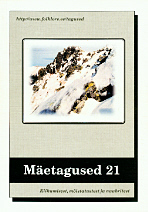Eestlaste kiigekultuur enne ja nüüd
Swing culture of the Estonians in the past and today
Author(s): Anu VisselSubject(s): Customs / Folklore
Published by: Eesti Kirjandusmuuseum
Summary/Abstract: The present article explores Estonian swing culture - the types of swings, temporal-spatial relationships and customs related to swinging, swing songs, dances and games, innovations brought to swing culture in the 20th and 21st centuries. The observations are based on the archive materials of the Estonian Folklore Archives, and partly on those of Estonian National Museum. Originally swinging had a magical meaning. The belief that swinging in springtime facilitates the growing of crop and good health of cattle and people was widely spread among Finno-Ugric, Slavic and other peoples, and naturally also among Estonians. Although the Estonian territory is small, there were considerable differences between South and North Estonian traditions. In the 19th century, swinging in Southern Estonia was performed in a specific time frame (only during the Easter), swings were lightly constructed (rope swings or lighter wood swings), both young and older people were expected to participate in swinging and it served more of a ritual function. In Northern Estonia, where swinging was not practiced until the Whitsuntide, i.e. during the Summer season, but for a longer period (until Midsummer Day), heavy village swings were common. During festivities and weekends virtually all of the adult community gathered around these, although swinging performed by the young and single. The large swing of Northern Estonia is Swedish in origin. The swing tradition of Northern Estonia bears remarkable resemblance with the village swing tradition of Western Finland. Village swings helped young people to communicate with each other and offered opportunity of social interaction to all village inhabitants regardless of their age. Swings were built on the public land of the village by single young men, and people who came swinging brought presents to swing makers. Young girls were expected to sing special songs, because singing was an important part of Estonian swing culture. Swing songs make up a popular and distinct song group in Northern Estonia (see sound and note examples) that differ from the rest of the runo songs in terms of their specific singing techniques (strong chest voice, many melismata, twirls, extra syllables), slow rhythm controlled by the movements of the swing and slow tempo. In addition, texts of these songs are outstanding in their rich poetics. The oldest layer of swing melodies are made up of North-Estonian single-line melodies that are characterised by long end sound and range up to fourth; these are likely to belong to the oldest Finno-Ugric melody layer. Swing melodies as a peculiar and representative group of melodies have influenced both other song types of North Estonia and these of adjacent nations (Izhorians and Votians). There were specific swing songs in Southern and Northern Estonia.
Journal: Mäetagused. Hüperajakiri
- Issue Year: 2003
- Issue No: 21
- Page Range: 7-84
- Page Count: 78
- Language: Estonian

